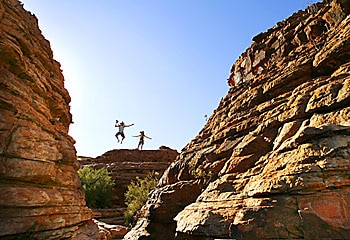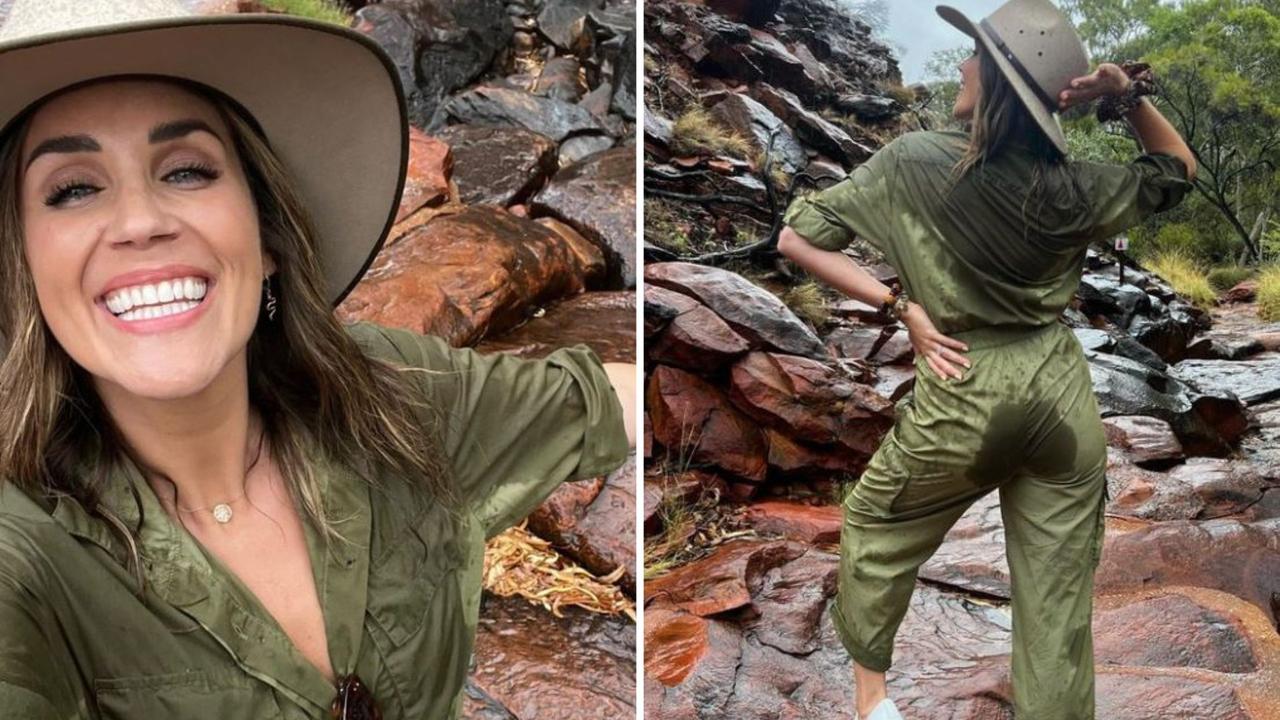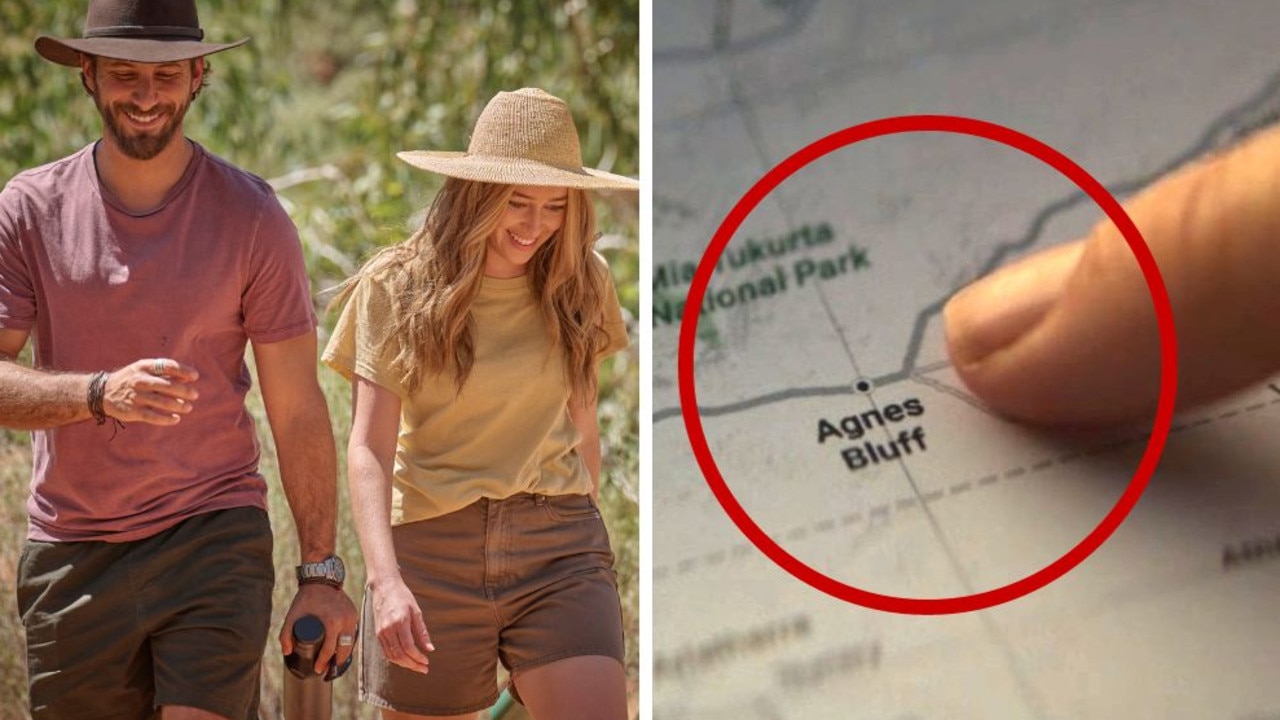Quickly, into Kings Canyon
THE Northern Territory is now more geared towards shorter stays, reports Jim Dickins after two glorious days at Kings Canyon, between Uluru and Alice Springs.

THE road between Uluru and Alice Springs is richer in stories than it ever was in gold, as the doomed prospector Harold Lasseter found to his cost.
Lasseter, who died nearby in 1930 searching for his fabled reef of gold, gave his name to the highway which connects central Australia's biggest tourist destination with the outside world.
In the process he joined the long list of characters who populate this awe-inspiring landscape, merging the rich heritage of Aboriginal occupation with subsequent European exploration and settlement.
As we travelled north along Lasseter's Highway in April, heading for the new four-star Kings Canyon Wilderness Lodge in the foothills of the MacDonnell Ranges, our guide Myles McClure proved a font of knowledge from both traditions.
After landing at Ayers Rock Airport, with its tantalising views of Uluru, we paused for lunch and a quick photo stop.
Like the 19th-century explorer Ernest Giles, who was the first European to see the area in the 1870s, we had to content ourselves with a brief glimpse for now.
As Myles explained, Giles was unable to reach here on his first sighting from Kings Canyon, and was eventually beaten to Uluru by his rival, William Gosse.
Unlike Giles, however, we would have plenty of time to explore on our return journey, before flying home.
About 80km up the highway, the strange profile of Mount Connor appeared, its elongated shape and ochre tinge showing why many tourists travelling in the opposite direction mistake it for Uluru itself. Known as Attila by the region's indigenous people, Mount Connor is the least-known, easternmost outcrop of a group of giant rock features that includes Uluru and the Olgas.
In Aboriginal mythology, Attila is home to the icemen, whose wanderings leave frozen footprints – frosts which carpet the desert in winter.
Nearby lies the first roadhouse along the highway, at Curtin Springs Station. The communist leanings of its early leaseholder, Abraham Andrews, prompted him to consider naming it "Stalin Springs" but his sons persuaded him to honour Labor's wartime PM John Curtin instead.
A left-turn onto the Luritja Highway took us west, traversing the southern flanks of the MacDonnell Ranges to our destination at Kings Creek Station.
Here, station owner Ian Conway, who traces both indigenous and European pioneer ancestry, has developed an eco-resort with Australian Pacific Tourism.
The APT-managed tented cabins are a product of the company's new short-breaks philosophy, an attempt to move away from the usual two-week outback coach tour by providing brief two-or three-day escapes.
The cabins feature tent-like canvas walls, with a timber floor and ensuite bathrooms.
Our short break began with drinks and dips on a hilltop above the resort, watching the sun set over the ranges.
Dinner followed, beginning with Moreton Bay bug tails marinated in bush spices pepperberry, wattleseed, lemon myrtle and mountain black pepper.
Some of the Northern Territory's zoological symbols featured heavily in the next course, which included camel steaks wrapped in prosciutto, barramundi marinated in olive oil and kangaroo fillet rolled in mustard seed and saltbush.
We dined outdoors under the bright desert stars at the newly opened lodge, but winter chills would force diners into the indoor kitchen/dining building.
Even in April, night-time temperatures were dropping, and the magnetism of an open campfire inevitably drew us to its side, coaxing more tales from Myles about the area's history.
Among the gems were highlights from the the colourful Conways' early years at Kings Canyon, when their homestead consisted of little more than a shack.
Next morning, an early breakfast of poached eggs, toast, fresh fruit and pastries preceded an excursion within the station boundaries to the site of a mysterious group of rock carvings, showing tiny feet and emu prints.
Ian Conway discovered it during his frequent criss-crossings of his vast property by motorbike, four-wheel-drive and camel.
A classic outback identity, Ian was one of the first to discover the Middle East market for Australia's feral camels, which run wild across the station.
In the early days, mustering was a basic affair which sometimes involved wrestling the animals practically by hand after leaping from a moving vehicle.
Ian explained that his deep love of the land made station life a pleasure, despite the hardships of raising three children in such a remote location. "You can feel the gladness come over you as you drive into the bush," he told us.
Kings Canyon was formed by water eroding fault lines in the ridge, its orange ochre walls rising more than 100m from the plain.
Several marked walking tracks pass the main scenic points, including a semi-permanent waterhole, the Garden of Eden, which supports a lush stand of ancient cycads, as well as a family of ducks.
We walked the 6km loop track, which climbs to the summit, past strange dome formations to spectacular viewing points into the canyon and across the desert floor.
A shorter 2km track provides access to the lower section and is advisable for those less mobile, especially in summer when temperatures can soar dangerously.
The trails give a wide berth to an important sacred Aboriginal site but the 6km loop passes more rock art where children's handprints mark a small cave.
Other popular sites include locations for the movie Priscilla, Queen Of The Desert, parts of which were filmed here.
Our day ended with more stories among desert oaks which surround the wilderness lodge.
Next morning we retraced our way along the highway, taking time to explore the base of Uluru before returning by air from our short break in a different world.
The writer was a guest of APT.
The Sunday Telegraph



